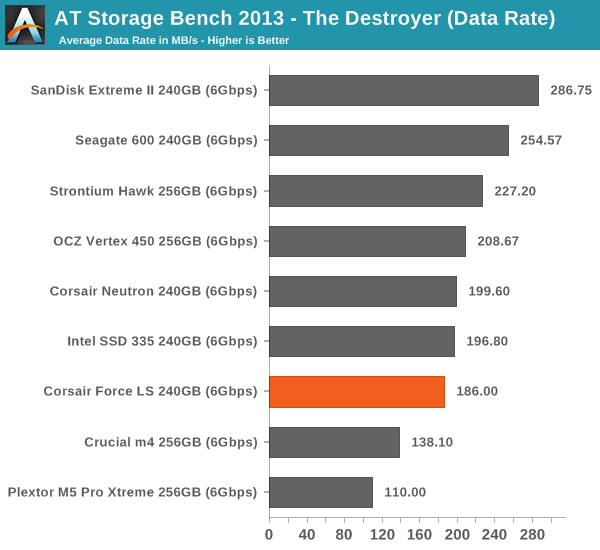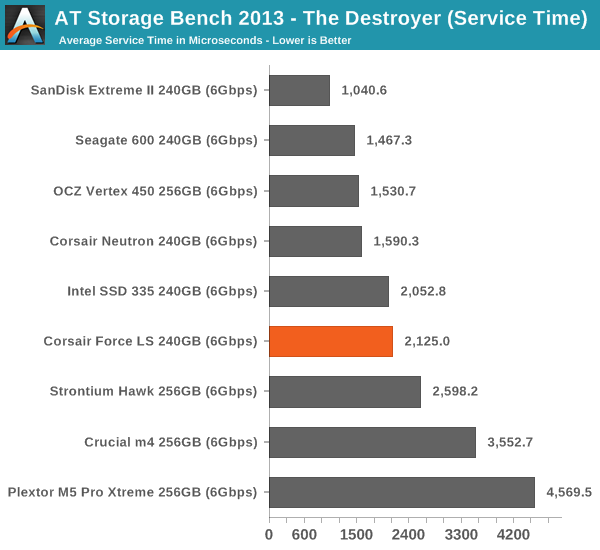Corsair Force LS (240GB) Review
by Kristian Vättö on September 25, 2013 12:00 AM ESTAnandTech Storage Bench 2013
When Anand built the AnandTech Heavy and Light Storage Bench suites in 2011 he did so because we didn't have any good tools at the time that would begin to stress a drive's garbage collection routines. Once all blocks have a sufficient number of used pages, all further writes will inevitably trigger some sort of garbage collection/block recycling algorithm. Our Heavy 2011 test in particular was designed to do just this. By hitting the test SSD with a large enough and write intensive enough workload, we could ensure that some amount of GC would happen.
There were a couple of issues with our 2011 tests that we've been wanting to rectify however. First off, all of our 2011 tests were built using Windows 7 x64 pre-SP1, which meant there were potentially some 4K alignment issues that wouldn't exist had we built the trace on a system with SP1. This didn't really impact most SSDs but it proved to be a problem with some hard drives. Secondly, and more recently, we've shifted focus from simply triggering GC routines to really looking at worst-case scenario performance after prolonged random IO.
For years we'd felt the negative impacts of inconsistent IO performance with all SSDs, but until the S3700 showed up we didn't think to actually measure and visualize IO consistency. The problem with our IO consistency tests is that they are very focused on 4KB random writes at high queue depths and full LBA spans—not exactly a real world client usage model. The aspects of SSD architecture that those tests stress however are very important, and none of our existing tests were doing a good job of quantifying that.
We needed an updated heavy test, one that dealt with an even larger set of data and one that somehow incorporated IO consistency into its metrics. We think we have that test. The new benchmark doesn't even have a name, we've just been calling it The Destroyer (although AnandTech Storage Bench 2013 is likely a better fit for PR reasons).
Everything about this new test is bigger and better. The test platform moves to Windows 8 Pro x64. The workload is far more realistic. Just as before, this is an application trace based test—we record all IO requests made to a test system, then play them back on the drive we're measuring and run statistical analysis on the drive's responses.
Imitating most modern benchmarks Anand crafted the Destroyer out of a series of scenarios. For this benchmark we focused heavily on Photo editing, Gaming, Virtualization, General Productivity, Video Playback and Application Development. Rough descriptions of the various scenarios are in the table below:
| AnandTech Storage Bench 2013 Preview—The Destroyer | ||||||||||||
| Workload | Description | Applications Used | ||||||||||
| Photo Sync/Editing | Import images, edit, export | Adobe Photoshop CS6, Adobe Lightroom 4, Dropbox | ||||||||||
| Gaming | Download/install games, play games | Steam, Deus Ex, Skyrim, Starcraft 2, BioShock Infinite | ||||||||||
| Virtualization | Run/manage VM, use general apps inside VM | VirtualBox | ||||||||||
| General Productivity | Browse the web, manage local email, copy files, encrypt/decrypt files, backup system, download content, virus/malware scan | Chrome, IE10, Outlook, Windows 8, AxCrypt, uTorrent, AdAware | ||||||||||
| Video Playback | Copy and watch movies | Windows 8 | ||||||||||
| Application Development | Compile projects, check out code, download code samples | Visual Studio 2012 | ||||||||||
While some tasks remained independent, many were stitched together (e.g. system backups would take place while other scenarios were taking place). The overall stats give some justification to what we've been calling this test internally:
| AnandTech Storage Bench 2013 Preview—The Destroyer, Specs | |||||||||||||
| The Destroyer (2013) | Heavy 2011 | ||||||||||||
| Reads | 38.83 million | 2.17 million | |||||||||||
| Writes | 10.98 million | 1.78 million | |||||||||||
| Total IO Operations | 49.8 million | 3.99 million | |||||||||||
| Total GB Read | 1583.02 GB | 48.63 GB | |||||||||||
| Total GB Written | 875.62 GB | 106.32 GB | |||||||||||
| Average Queue Depth | ~5.5 | ~4.6 | |||||||||||
| Focus | Worst-case multitasking, IO consistency | Peak IO, basic GC routines | |||||||||||
SSDs have grown in their performance abilities over the years, so we wanted a new test that could really push high queue depths at times. The average queue depth is still realistic for a client workload, but the Destroyer has some very demanding peaks. When we first introduced the Heavy 2011 test, some drives would take multiple hours to complete it; today most high performance SSDs can finish the test in under 90 minutes. The Destroyer? So far the fastest we've seen it go is 10 hours. Most high performance SSDs we've tested seem to need around 12—13 hours per run, with mainstream drives taking closer to 24 hours. The read/write balance is also a lot more realistic than in the Heavy 2011 test. Back in 2011 we just needed something that had a ton of writes so we could start separating the good from the bad. Now that the drives have matured, we felt a test that was a bit more balanced would be a better idea.
Despite the balance recalibration, there's just a ton of data moving around in this test. Ultimately the sheer volume of data here and the fact that there's a good amount of random IO courtesy of all of the multitasking (e.g. background VM work, background photo exports/syncs, etc...) makes the Destroyer do a far better job of giving credit for performance consistency than the old Heavy 2011 test. Both tests are valid; they just stress/showcase different things. As the days of begging for better random IO performance and basic GC intelligence are over, we wanted a test that would give us a bit more of what we're interested in these days. As Anand mentioned in the S3700 review, having good worst-case IO performance and consistency matters just as much to client users as it does to enterprise users.
We're reporting two primary metrics with the Destroyer: average data rate in MB/s and average service time in microseconds. The former gives you an idea of the throughput of the drive during the time that it was running the Destroyer workload. This can be a very good indication of overall performance. What average data rate doesn't do a good job of is taking into account response time of very bursty (read: high queue depth) IO. By reporting average service time we heavily weigh latency for queued IOs. You'll note that this is a metric we've been reporting in our enterprise benchmarks for a while now. With the client tests maturing, the time was right for a little convergence.

Our new Storage Bench 2013 reillustrates the IO consistency results. The Force LS does okay but it's clearly far behind the fastest SSDs of today. For an average user this shouldn't be an issue as the SSD shouldn't end up in steady-state in a TRIM supported environment but for a heavy user this can be a concern.











25 Comments
View All Comments
Runamok81 - Wednesday, September 25, 2013 - link
Looks like we have a shrinking middle-class withh SSDs as well. Does this mean manufactuers should focus on one extreme of the performance/value slider or else risk consumers purchasing leftover stock from last years tech?MrSpadge - Wednesday, September 25, 2013 - link
The problem with budget and middle class SSDs is that the bulk of the cost goes into the flash - which you have to buy anyway. The controller does cost a bit, but you can't save much by making an SSD slower. That's why it's not really worth it for customers to spend a little less for a significantly slower SSD. Exception: Samsung 840/840 Evo. they've still got the excellent controller and at least decent performance, yet they mostly cost significantly less than others.ericbentley - Monday, September 30, 2013 - link
Samsung 840/840 Evo can afford to use a good controller yet still be budget oriented because they use TLC flash, while the Corsair LS here still uses MLC. While MLC is better in terms of longevity, most people still want the benefits of speed from the controller and MLC vs TLC is a back-burner issue for themI'm wondering if Corsair had tried TLC before and had some reason for not using it for a drive like this, seems like a no brainer to me, unless they couldn't secure a large enough supply
Kristian Vättö - Wednesday, September 25, 2013 - link
I think we are starting to get to a similar point as where DRAM is now. For an average user, the difference between a low-end and high-end SSDs is becoming negligible because even the low-end SSDs are pretty good now (e.g. the Force LS). That means the middle-class no longer serves a purpose because the average users will mostly go with the cheaper options and enthusiasts only want the fastest.vol7ron - Wednesday, September 25, 2013 - link
The big thing still out there, that hasn't been answered is lots of flash for cheap. When buying an SSD many customers look for the fastest, since the cost is marginal between what's available. However, the one area of the market that is still "expensive" is in the mass-flash +1TB (or even +512GB). Even with a slower controller/NAND, I think Corsair could slide into this space. Look at Apple and what they're shipping their new Mac with - what's it called? Fusion? - essentially a hybrid drive, rebranded. I'm sure a company that focuses on the best balance of quality vs cost, wouldn't do that if SSD costs were lower. --- There's still the niche market for high capacity flash, the ultimate HDD terminator.Spoony - Sunday, September 29, 2013 - link
Apple is shipping a 128GB SSD alongside a normal platter drive in 1TB or 2TB configurations. Fusion Drive is just the name for a logical volume manager with block migration. They are not re-branding a hybrid drive like a Momentus XT. It is a custom solution which merges two discrete devices in software. For better or worse.I definitely agree with you. 1-2TB SSDs at $0.40/MB rather than the current $0.95/MB would be very compelling. I would buy if it was reliable, even if it wasn't blazing fast.
Spoony - Sunday, September 29, 2013 - link
1TB or 3TB configs. Not 2TB. Sorry.Also, edit functionality would be convenient.
Cumulus7 - Wednesday, September 25, 2013 - link
Since you recommend the Samsung EVO over the Crucial M500: aren't yout concerned that the EVO may not last as long as the M500?I prefer the M500 at the moment since i expect its NAND to last a lot longer. But i may be wrong...
fokka - Wednesday, September 25, 2013 - link
of course mlc should theoretically last longer, but that doesn't mean tlc doesn't last more than long enough, as you can read here:http://www.anandtech.com/show/7173/samsung-ssd-840...
MrSpadge - Wednesday, September 25, 2013 - link
I'd choose and recommend the Evo as well, for all typical users. People write much less on average than they fear they might. It's only a different story for power users, servers etc.